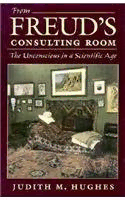
From Freud's Consulting Room: The Unconscious in a Scientific Age PDF
Preview From Freud's Consulting Room: The Unconscious in a Scientific Age
From Freud's Consulting Room Also by Judith M. Hughes To the Maßinot Line: The Politics of French Military Preparation in the 1920}s (1971) Emotion and High Politics: Personal Relations at the Summit in Late Nineteenth-Century Britain and Germany (1983) Reshaping the Psychoanalytic Domain: The Work of Melanie Klein, W. R. D. Pairbairn, and D. W. Winnicott (1989) J U D I TH Μ. H U G H ES From Freude Consulting Room The Unconscious in a Scientific Age Harvard University Press Cambridge, Massachusetts, and London, England 1994 Copyright © 1994 by the President and Fellows of Harvard College All rights reserved Printed in the United States of America This book is printed on acid-free paper, and its binding materials have been chosen for strength and durability. Library of Congress Cataloginß-in-Publication Data· Hughes, Judith M. From Freud's consulting room : the unconscious in a scientific age / Judith M. Hughes, p. cm. Includes bibliographical references and index. ISBN 0-674-32452-8 (alk. paper) 1. Freud, Sigmund, 1856-1939. 2. Subconsciousness —History. 3. Psychoanalysis—History. 4. Clinical psychology—History. I. Tide. BF109.F74H845 1994 150.19'52'092—dc20 93-47172 CIP Designed by Gwen Frankfeldt Photograph of Freud's consulting room on p. 3d courtesy of Edmund Engelman For Allan D. Rosenblatt and Melford E. Spiro Acknowledgments When I am working on a book, I like to talk—and talk—about it. And over the years I have found a number of ready listeners, who have allowed me to try out ideas that were tentative or fragmentary and who have responded with queries and suggestions. Though they may not immediately recognize how they made a contribution to the final product, I do, and would like to thank the following: Roy G. D'An- drade, Reva P. Greenburg, Patricia W. Kitcher, Donald L. Kripke, George Mandler, Michael Meranze, Robert S. Westman, and Robert M. Young. When the book was just about finished, Ai'da D. Donald, editor-in-chief of Harvard University Press, gave it a careful reading and strong endorsement, and then Anita Safran did a discriminating and sensitive job of copy-editing. In London I incurred debts of gratitude to two directors of the Freud Museum, Richard Wells and Erica Davies, who gladly put at my disposal the Freud-Ferenczi correspondence. In La Jolla, I enjoyed and profited from the Psychoanalytic Interdisciplinary Seminar sponsored by the Department of Psychiatry at the University of California, San Diego. Very early on I presented to its members what I thought was an outline of a possible project. They good-humoredly but firmly told me that I had offered two possibilities, not one, that I had better make a choice, and also indicated their own preference. On this last point they were unanimous. Though the end result may bear only a slight resemblance to their recommendation, I am grateful for both the matter and the manner of the advice given. Roughly halfway through the writing, I became a clinical associate at the San Diego Psychoana- lytic Institute. The last chapter benefited most from this new affili- Acknowledgments ation, and I want to thank my colleagues for helping me read clinical material as if I were behind rather than simply on the couch. Once again the person who has borne the brunt of my talk has been my husband, Stuart. He has listened as I have struggled aloud to formulate lines of argument and to decide upon organizational tactics and strategy. He has read more than one version and has offered editorial suggestions each time round. And once again he has been patient and forbearing. I am grateful to Sigmund Freud Copyrights, The Institute of Psycho- Analysis, and The Hogarth Press for their kind permission to quote from The Standard Edition of the Complete Psychological Works of Sig- mund Freud, translated and edited by James Strachey. Permission has been granted by Basic Books, a division of HarperCollins Publishers, Inc., to quote excerpts from "Freud's Psycho-Analytic Method" (The Collected Papers of Sigmund Freud, Volume 1), "Fragments of Analysis of a Case of Hysteria" (Volume 3), "Analysis of a Phobia in a Five- Year-Old Boy" (Volume 3), and "Notes upon a Case of Obsessional Neurosis" (Volume 3); authorized translation under the supervision of Alix and James Strachey. Published by Basic Books, Inc., by arrange- ment with The Hogarth Press, Ltd., and the Institute of Psycho- Analysis, London. via Contents Introduction 1 1 Space for Meaning/Intention/Purpose A Focus on Consciousness A Focus on the Unconscious 2 Redefining the Body 21 Psyche and Soma Soma and Psyche "A Bodily Ego" 3 Redefining the Object 65 aRelics of Antiquity" Creations of Fantasy An Altered Ego 4 Modes of Conversation 109 "New* or aRevised Editions" aThe Chief Patient" Conflict within the Transference Conclusion: Let the Exploration Continue Contents Abbreviations 170 Notes 171 Selected Bibliography 205 Index 231
